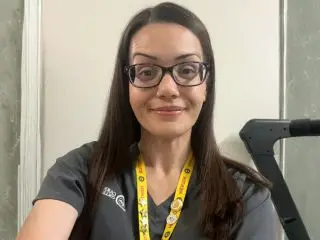 Carrington College’s Practical Nursing and Associate Degree in Nursing students have a tremendous tool to advance their medical education and patient care expertise: simulation. Simulators are as close to a human being as possible and SIM mannequins are the most advanced teaching tool in the college’s nursing classrooms. As the nursing programs’ Simulation Coordinator, it is Billie Jo Lund who maximizes its teaching potential and coaches students on its value in optimal patient care. As a Doctor of Nursing Practice (DNP), Billie Jo combines her extensive medical knowledge and patient care practices with these hi-tech, hands-on experiences to give students the greatest advantages and well-focused preparation for the medical careers they have chosen.
Carrington College’s Practical Nursing and Associate Degree in Nursing students have a tremendous tool to advance their medical education and patient care expertise: simulation. Simulators are as close to a human being as possible and SIM mannequins are the most advanced teaching tool in the college’s nursing classrooms. As the nursing programs’ Simulation Coordinator, it is Billie Jo Lund who maximizes its teaching potential and coaches students on its value in optimal patient care. As a Doctor of Nursing Practice (DNP), Billie Jo combines her extensive medical knowledge and patient care practices with these hi-tech, hands-on experiences to give students the greatest advantages and well-focused preparation for the medical careers they have chosen.
What are your responsibilities as Simulation Coordinator?
In the simulation center, I run mock patient scenarios – which incorporate various patient care situations. The simulations may include medical-surgical, pediatric, OB or mental health patient care situations. Simulations teach students the process of clinical thinking and critical judgement in patient care. See the symptoms and ask, “What do I do to address this issue?” Simulation teaches them to use all their senses and not function by rote. It’s the critical thinking development that benefits them prior to practicing.
What is a simulator (mannequin) like, exactly?
They range from task trainers (IV arm), low fidelity simulators (partial torso) to high fidelity mannequins that sweat and bleed. Medium to high fidelity simulators can vocalize ‘yes’ and ‘no’ as well as vomit, scream, moan and cough. Students can listen to their heart, lung and bowel sounds, as well as administer medications and run fluid and blood lines. The more real we make the experience for students, the better the learning experience for them. The biggest benefit of simulation is the students’ development of critical thinking and clinical judgement. It puts the experience into their hands – literally.
How important is simulation as a learning tool?
Nothing is more advanced out there. Simulation is a growing method of instruction in all fields. It’s like a computer in terms of its evolution and importance. We can design simulation exercises to address student weaknesses and educational needs. It is beneficial to any nursing program. Students really embrace this style of instruction. There’s a lot of creativity in simulation which sparks an outside-the-box kind of thinker.
How did you become proficient in simulation instruction?
I’ve been the Simulation Coordinator for Carrington College for 5 years. When I first began, there was no standard training program for simulation, so I did a lot of research, watched webinars and read articles to get to the point I am today. I also learned a lot when I studied for and received my Certified Healthcare in Simulation certification in September (2023).
What excites you about teaching in Carrington College’s nursing programs?
I have always been a forward thinker, so every semester I seek ways to make simulations more robust and mirror what is done in practice. Once they leave their program, I want students to be confident in their competency and comfortable in collaboration with their patients.
When do you know a student ‘gets it’ and is ready to move forward?
When you see them putting all the pieces together, they go into simulation and perform well. If I see they’re struggling, I revisit the content with them; show them the steps to get from the issue to the solution. And, when they perform well in simulation, that’s when I know they’ve got it. I have recent graduates come back to campus and thank me for being a ‘real person’. Those are the compliments that help you know that you are doing it right.
How do you support students who struggle?
I talk with them about my journey through nursing school, completing 5-degrees and 10-years of college to get to DNP level. I encourage them to stay focused and check off those milestones as they accomplish them. And I remind them that one can do anything for a year (the length of Carrington’s Practical Nursing program).
What do you most hope to give your nursing students?
My biggest goal for them is that by the time they complete this program, they have confidence in themselves and competency in their performance. Competency grows the more they do, but confidence is what they must find in themselves. Every semester I want to make it a more robust learning experience.
How has the simulation program grown over the years?
We have spent the last five years building up the SIM Lab program’s prototype that all our campuses have adopted. I am the Simulation Committee Chair and am connected to all our campuses that offer these programs – and in our region alone there are six.
How do you see your future at the college?
Overseeing simulation at the institutional level would be my wishful job. I am hoping there is a spot for me as a Dean of Simulation so that I can impact simulation on all campuses.



